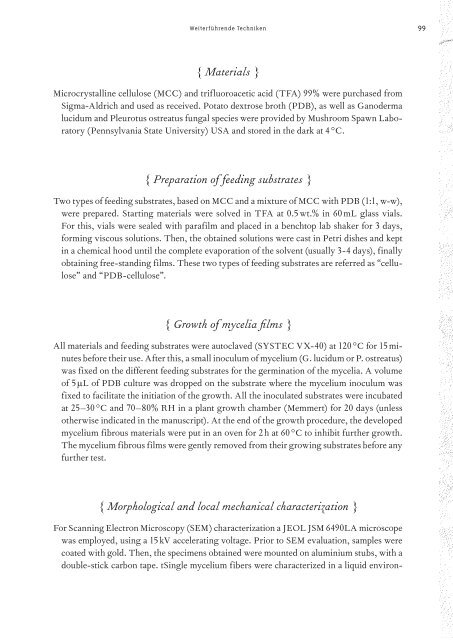Logbuch_17x24Druck_einzelseiten
Create successful ePaper yourself
Turn your PDF publications into a flip-book with our unique Google optimized e-Paper software.
Weiterführende Techniken<br />
99<br />
{ Materials }<br />
Microcrystalline cellulose (MCC) and trifluoroacetic acid (TFA) 99% were purchased from<br />
Sigma-Aldrich and used as received. Potato dextrose broth (PDB), as well as Ganoderma<br />
lucidum and Pleurotus ostreatus fungal species were provided by Mushroom Spawn Laboratory<br />
(Pennsylvania State University) USA and stored in the dark at 4 °C.<br />
{ Preparation of feeding substrates }<br />
Two types of feeding substrates, based on MCC and a mixture of MCC with PDB (1:1, w-w),<br />
were prepared. Starting materials were solved in TFA at 0.5 wt.% in 60 mL glass vials.<br />
For this, vials were sealed with parafilm and placed in a benchtop lab shaker for 3 days,<br />
forming viscous solutions. Then, the obtained solutions were cast in Petri dishes and kept<br />
in a chemical hood until the complete evaporation of the solvent (usually 3-4 days), finally<br />
obtaining free-standing films. These two types of feeding substrates are referred as “cellulose”<br />
and “PDB-cellulose”.<br />
{ Growth of mycelia films }<br />
All materials and feeding substrates were autoclaved (SYSTEC VX-40) at 120 °C for 15 minutes<br />
before their use. After this, a small inoculum of mycelium (G. lucidum or P. ostreatus)<br />
was fixed on the different feeding substrates for the germination of the mycelia. A volume<br />
of 5 μL of PDB culture was dropped on the substrate where the mycelium inoculum was<br />
fixed to facilitate the initiation of the growth. All the inoculated substrates were incubated<br />
at 25–30 °C and 70–80% RH in a plant growth chamber (Memmert) for 20 days (unless<br />
otherwise indicated in the manuscript). At the end of the growth procedure, the developed<br />
mycelium fibrous materials were put in an oven for 2 h at 60 °C to inhibit further growth.<br />
The mycelium fibrous films were gently removed from their growing substrates before any<br />
further test.<br />
{ Morphological and local mechanical characterization }<br />
For Scanning Electron Microscopy (SEM) characterization a JEOL JSM 6490LA microscope<br />
was employed, using a 15 kV accelerating voltage. Prior to SEM evaluation, samples were<br />
coated with gold. Then, the specimens obtained were mounted on aluminium stubs, with a<br />
double-stick carbon tape. tSingle mycelium fibers were characterized in a liquid environ-


